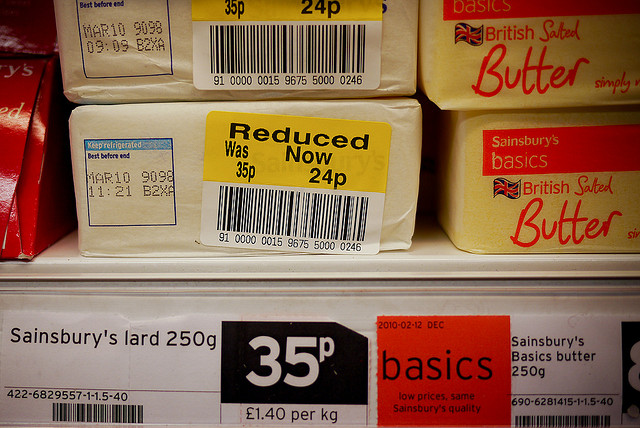- Present bias. This is an overvaluing of the present compared with the future. This might be manifest in choices that look like immediate gratification or in ones that look like procrastination. An insurance example might be customers only considering premium cost now, not a full comparison of the cover provided for the future.
- Reference dependence and loss aversion. Loss aversion can be seen in tests where people will consistently seek to avoid a loss that is certain, even if having to take a gamble or pay more to do so. Reference dependence is the assessing gains or losses in comparison with a subjective reference point. Retailers use this a lot. I’m sure you’ve experienced supermarket product pricing manipulated to make a relatively expensive choice look more mid-market by comparing that choice with higher, “dummy prices.” For an insurance example: Customers might make different decisions if just shown the costs of monthly or annual premiums on a renewal letter, as opposed to seeing a comparison with last year’s premium, as well.
- Regret and other emotions. Here we are dealing with irrational actions to avoid experiencing such negative emotions in the future. This might involve procrastinating on important decisions, like being checked out by a doctor, or willingness to pay for products that avoid decision making (like premium products promising to cover everything you need). A worrying example for insurers is consumers' unwillingness to engage with a need for life insurance, because of their discomfort with imagining the death of a loved one.
- Overconfidence. That is, overconfidence about the likelihood of future events or our abilities, or rationalizing past events (with the benefit of hindsight). For instance, almost all drivers believe they are above average. Another example is what’s called the planning fallacy, where most people consistently underestimate how long it will take them to get something done. Within insurance customers, we can see this bias at work in consistent under-estimating of cover needed or assuming an ability to self-insure or financially cope without protection.
- Over-extrapolation. Here we are dealing with making predictions on the basis of too few data points. A classic example is in the behavior of most investors. Most people will underestimate the level of uncertainty and buy or sell shares on the basis of insufficient data to make a robust forecast. One could say that the same behavior is also exhibited in consumers' use of insurance comparison sites. Undue importance can be given to simply the cheapest price or known brands, to shortcut decision-making time, rather than make a rational comparison of cover, service, recommendations, etc.
- Projection bias. This is the expectation that your current feelings, attitudes and preferences will continue into the future. So, you underestimate the potential for change. A classic example of this is the effect of the weather on sales of houses and cars. The feel of a house, or looks of a car, on a sunny day is projected into the future and bought without sufficient investigation -- leading to higher sales on sunny days. An insurance example could be seen in the low engagement of the working population with critical illness cover or health insurance, because of a projection of current good health into the future.
- Mental accounting and narrow framing. This is the behavior whereby people treat money or assets differently according to the purpose assigned to them, and consider such decisions in isolation rather than look at the overall impact. For instance, people not paying off debts while putting funds into savings accounts with lower interest rates. An insurance example is perhaps the estimates made of sum insured, which are more driven by impact on regular premium and budget allocated, rather than purchases made and value of possessions.
- Framing, salience and limited attention. This means reacting differently to essentially the same choice, because it is presented differently, partly because of limited attention to all but the most salient points. For example, shoppers are more likely to buy meat labelled 75% lean than meat labeled 25% fat. For an insurance example, consider the different responses to financial statements when the same information is simply presented in different ways. Simpler presentation that causes the most important information to be salient can change engagement and action.
- Decision-making “rules of thumb,” or heuristics. This is the tendency to simplify complex decisions by choosing more familiar, status quo or less ambitious questions instead. An example is where interviewers will choose candidates most like known colleagues or be swayed by stereotypes. For insurance, one sees customers simplifying many decisions in this way, for instance: “Is my pension fund performing well, and do I need to increase my contributions to achieve my goal?” can be simplified to: “Is anything wrong, and do they say I have to do anything now?”
- Persuasion and social influence. This behavior includes being persuaded because a seller is likable or comes across as a good person. There are examples of people being unduly swayed by apparent social norms, like increases in recycling because local government shares the percentage of others in your area who are recycling. For insurance, the change in consumers assuming that they “should” use comparison sites to shop around, because of an impression that everyone does so now, has been influenced by consistent advertising on TV and other media. It is interesting to see this reflected in customers who make a buying decision first, then find some evidence on a comparison site to justify the choice afterward.
How Customers Really Think About Insurance
The field of behavioral economics describes 10 irrational biases, but too few insurers are taking advantage of the knowledge.








